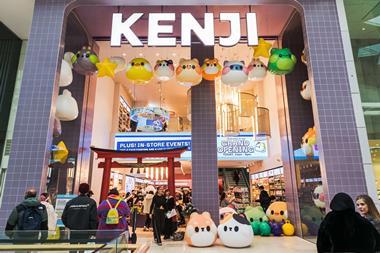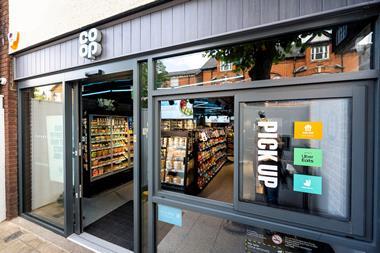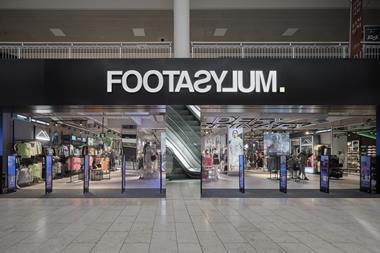It is probably a little premature for rivals to be dancing on Styles & Woods’ grave, because the corporate body at the head of this year’s Top Shopfitters league table is alive and well – albeit somewhat diminished. And, as in previous years, it has occupied that slot by garnering sales over£100 million more than its nearest rival, Wates Retail, which takes the second place.
Among the top five, the decision to include Simons Construction (third) is likely to prove contentious, for no better reason than that the figure includes a number of large-scale building projects as well as fit-outs. But considering this company has been building a fair proportion of B&Q’s new stores, including the forthcoming New Malden eco-store, its position is more than justified.
Working down the table, Morris & Spottiswood and Havelock Europa have both recorded modest increases in percentage terms, while Simpson retains its sixth place spot from last year.
Seventh place is something of an anomaly. ISG Retail and Leisure didn’t exist last year and the company name is the outcome of the fusion of Cathedral Contracts and Dean and Bowes. For this reason, there is no information available for the prior year.
Overall, however, the picture is generally rosy. Or so it would appear. The trouble with surveys is that the best that can be hoped for is a snapshot of how things are looking at the point at which the information was gathered. Ordinarily, this wouldn’t be too much of a problem as the data would be fresh(ish), but for the sake of a level playing field and because financial year-ends tend to occur throughout the calendar year, it makes sense to record the latest financial year of any company alongside the previous year, to provide a comparison.
Cast your eye down the list and a lot of the entries are for the year that ended on December 31. Again, this might not matter if it were not for the fact that there is evidence everywhere you look that we are on a downward path economically. Therefore, even information supplied for the end of last year is likely to look more than a little dated.
The question that really needs to be asked is how are shopfitters doing at the moment and are they in the same boat as many of the retailers that they supply? Curiously, they all appear to be busy. Terry Foley, accounts director at Andover-based shopfitter Oakwood (ranked 29), which numbers Arcadia, HMV and Vodafone among its clients, puts the case clearly: “I can’t swear that we’ll be here in 12 months or that we’ll do more business this year. But, at the moment, we’re flat out.”
Foley says that retailers carrying out roll-out programmes tend to do so for a couple of years and then “turn the tap off”. He explains: “If you’re a shopfitter and you manage to hold on to a client for 10 years, you’ve done really well.”
His words sound like a reality check for those who see a future in which last year’s benign conditions keep on rolling, irrespective of the fact that customers aren’t hitting the shops in quite the way many expected just 12 months ago. That Oakwood and many outfits like it are busy at present is a reflection of the fact that new retail property continues to be built. The shopping centres and high street remodelling programmes that were already signed, sealed, and are being delivered at the moment, are the product of an investment climate very different to the one we are in at present.
And it is possible that the real problems have yet to make themselves apparent. The completion of developments such as Land Securities and Hammerson’s Cabot Circus in Bristol, Westfield London or, further north, Grosvenor’s Liverpool One scheme, looks like the conclusion of a very rich feast for the shopfitting fraternity. For most, this is a busy time, but then it always has been – for no better reason than that retailers want shops to be up and running for prime trading in time for the Christmas period.
Whether you’re John Lewis in Leicester or the Ferrari franchise holder on Regent Street, you are likely to be pushing your shopfitter to get work done quickly. However, most shopfitters report that while the work is there, margins are significantly slimmer than 12 months ago. Many are saying that retailers have been quick to opt for a lowest price wins mentality when it comes to fitting out shops, sometimes with indifferent results.
Dominic Perks, chief executive of Stoke-on-Trent-based shopfitter Uno Retail Solutions (in 27th place), says: “We’re seeing companies buy work, which is very frustrating. Amazingly, we do turn down work. For a little shopfitter [one that Perks forecasts will wind up taking£24 million this year – a 20 per cent increase on 2007], we’re pretty strategic about what we do.”
Translated, this sounds like the familiar adage that profit is sanity, turnover is vanity. It’s a view that strikes a chord with Morris & Spottiswood chairman George Morris. He says: “We’ve been steady with our fit-out for three years now, but mainly because we haven’t pushed it. If you’ve got a business division that isn’t going to be that great, why would you pursue it?”
Morris says that the fickle nature of the retail fit-out market at present is particularly frustrating. “We don’t really mind low margins, but it’s when jobs are pulled with just weeks to go,” he explains.
This brings to mind the framework agreements that not so long ago always seemed to form one of the criteria for shopfitting success. As retailers tighten their belts, such agreements are likely to be one of the casualties of the downturn.
All of which does not have to mean that things are likely to turn out to be pretty bleak, according to Perks. He says that it’s a matter of how a shopfitting business behaves. “There’ll be plenty of shopfitting business, but it will be confined to certain sectors,” he says. “I’d try to diversify my client base and I’d be very cautious about credit risks.”
Perks adds that many shopfitters have not proved diligent enough when assessing whether they should commit their resources to a particular retail client.
Pursue this line of thinking and the inevitable question is which sectors are likely to prove the most reliable payers and to have programmes of work that shopfitters can get their corporate teeth stuck into.
Certainly, food retailers have shown growth this year and the high profile acquisition of four Woolworths sites by Waitrose, for example, must provide shopfitters with a measure of encouragement. The other area that continues to enjoy substantial increases is value retailing, where the likes of Aldi, Lidl and the convenience store operators keep opening new outlets.
Finally, what about the casualties? The interesting point is how few there are. Broadly speaking, the names that were in the Top Shopfitters league table last year are still there this year.
Allowing for the fact that this is a survey of the largest shopfitters that the UK has to offer, this is not entirely surprising. Brendan Boyd, director of retail fit-out at Northern Ireland-based Patton Fit-Out (ranked eighth), says: “Things aren’t as bad as they’ve been painted, but the smaller companies will definitely be struggling.” This looks pretty close to the truth: in any contract to fit-out a shop, the risk cuts both ways and unless a retailer perceives that a shopfitter has the resources to deliver a job, in uncertain times it will be reluctant to commit itself to that company.
It seems reasonable to assume from all of this that the very large companies will ride out the storm and probably emerge stronger, because the shopfitting sector will have been subjected to the kind of shake-out that has long been forecast. Not entirely bad news, therefore, if you happen to be in Retail Week’s Top Shopfitting league table; a rather different story if you are not big enough to merit inclusion. Size really does matter.


























No comments yet